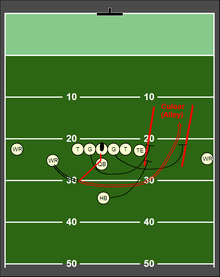Motion (gridiron football)
In gridiron football, motion refers to the movement of an offensive player at the time of the snap.

While there are different rules regarding motion, most mandate that no more than one player may be in motion at the time of the snap,[1] and the player must not be an offensive lineman (typically, the player in motion is a wide receiver or running back).[2] Additionally, the NFL (professional), NCAA (college), and NFHSAA (high school) require that they be moving laterally or backwards; they are not allowed to be moving towards the line of scrimmage when the ball is snapped.[3] The Canadian Football League and the Arena Football League allow for motion towards the line of scrimmage at the time of the snap.[4][5]
Motion and shift
There is a distinction drawn between a shift and motion in football. Motion occurs when a player is moving at the time of the snap. A shift occurs when one or more players changes their position on the offensive side of the ball before the snap, causing a change in formation.
Penalties
The National Football League defines all motion and shift penalties as "illegal motion",[6] while both the NCAA and NFHSAA make a distinction between an "illegal shift" and "illegal motion"; an illegal shift refers to players shifting and not coming to a complete stop before the snap while illegal motion refers to a player who is in motion towards the line of scrimmage, or a player who is not a "back" in motion.[7] In both leagues, however, the penalty for illegal motion/illegal shift is five yards from the previous spot and replay the down.
Additionally, the offensive team may be charged with the penalty of a "false start" if a player on the offense jumps or moves abruptly, simulating the start of the play. This movement is not normally considered a subset of the "motion" or "shift" rules, as the player is not judged to be moving into a new pre-snap position; he is merely starting the play too soon. This is also a five-yard penalty.
History and purpose

In the earliest days of American football, offenses were allowed to shift and assemble themselves as much as they wanted, much as defenses do. The famous Notre Dame Box relied heavily on these shifting motions. However, rule changes were eventually implemented that prevented offenses like the Notre Dame Box from ever occurring again. The motion rules seen today resulted from these rule changes. Currently, wholesale formation shifts can only occur before the offensive formation is set, and said formation must be in place for at least one second before a snap or motion can occur.
The purposes of motion are to allow the offense to change formations, and to gain clues about the defensive playcall, particularly whether the play is "zone" or "man-to-man" coverage (typically, a defense playing "man-to-man" coverage will have a single defender follow the offensive man-in-motion across the formation, whereas in a "zone" defense, as the man-in-motion travels across the formation, which defender is assigned to cover him will change, causing the entire defensive formation to shift to accommodate the modified coverage assignments), which can often cause the offensive team to modify its own playcall, using an audible, to a play that is better suited to defeating the defense's strategy. In leagues that allow forward motion, motion can offer a chance to gain momentum on the defenders.
Requirements
In all forms of football, only players in the backfield and not on the line of scrimmage may be in motion at the time of the snap. Prior to starting the motion, all players on the offensive side must be in a set formation for a minimum of one second.
In most versions of American football, only one player may be in motion at one time, and the player must not move toward the line of scrimmage in his motion (in other words, he can only move laterally or backward). In no situation may the moving player begin on the line of scrimmage when he moves (in other words, offensive linemen are prohibited from motion prior to the snap). Any player who shifts from a lineman position to a back position must set in position at least five yards behind the line of scrimmage before going into motion.
Exceptions are as follows:
- Pro Bowl: Motion is prohibited.[8]
- XFL (2001), WFL, Arena Football League and most other indoor football leagues: One player in motion is allowed; he can move toward the line of scrimmage only if he is outside the offensive tackles. (The 2020 XFL has not indicated whether or not it will revive the forward motion rule.)
- American Indoor Football: Two players in motion were allowed, both could move toward the line of scrimmage, one each outside the guard or tight end.
- Canadian football: All backfield players are allowed to move toward the line of scrimmage before the snap, regardless of their horizontal position.
In leagues that allow forward motion, the moving player(s) cannot cross the line of scrimmage, otherwise a false start penalty is called.
References
- "Ask the Official: How Many Players Can Be In Motion Before the Snap?". nflflag.com. Retrieved January 19, 2019.
- Schwartz, Geoff. "Learn How to Watch an NFL Game Like an Expert". SB Nation. Retrieved January 19, 2019.
- "NCAA Rule 7 – Snapping and Passing the Ball". ruletool.info. Retrieved January 19, 2019.
- "Ask the Ref: A Conversation with Tom Higgins". cfl.ca. August 8, 2011. Retrieved January 19, 2019.
- "Rules of the Game: The Players, Alignment, Action and Equipment". aalfootball.com. Retrieved January 19, 2019.
- "NFL official rule book" (PDF). nfl.com.
- NCAA official football rules
- Tolj, James. "10 Reasons Nobody Cares About the NFL Pro Bowl". bleacherreport.com.
Further reading
- National Federation of State High School Associations Rule Book, 2001